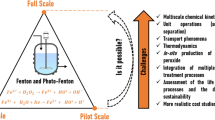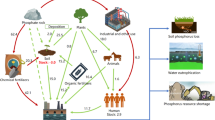Abstract
Emitter clogging is a bottleneck to restrain the application and popularization of reclaimed water drip irrigation technology, and it is tightly related to the formation of biofilms attached on drip irrigation emitters. However, there is still no quantitative description about the relationship between biofilms components and emitter clogging. Based on the reclaimed water drip irrigation experiment, the characteristics of biofilms attached on 7 kinds of emitters under reclaimed water drip irrigation have been systematically explored with phospholipid fatty acids (PLFAs) and other microbiological testing methods, and quantitative relationship between biofilms components and emitter clogging was analyzed. The results showed that emitter clogging degree and biofilms components revealed an increasing trend with the drip irrigation system running, which could be regarded as the “quick-slow-quick-slow” increasing trend. Biofilms exhibited a rapid growth after restarting in the 2nd year. The dry weights (DWs), PLFAs, and extracellular polymers (EPS) of biofilms attached on the emitters could reach up to 0.133 g, 100.83 μg, and 1,645.04 μg, respectively, after accumulatively ran for 540 h. DWs of biofilms in different positions such as head, middle, and end parts of the lateral also revealed a increasing trend. Meanwhile, biofilms in the pressure-compensating emitters grew less than that in the non-pressure-compensating emitters. During the initial 540 h of the system running, DWs, PLFAs, and EPS of attached biofilms had a obvious negative linear correlation (R 2 > 0.85) with emitter discharge ratio variation (Dra) and coefficient of uniformity (CU), which could describe the drip irrigation emitter clogging mechanism well. Furthermore, PLFAs reflected the type and quantity of microorganisms in attached biofilms, and sticky EPS secreted by microorganisms could link the microorganisms with absorbed particulates together and formed the stable biofilm structure. As PLFAs reflected the comprehensive effect of microorganisms, particulates and EPS on emitter clogging, and presented the highest negative linear correlation with Dra (R 2 = 0.93), it is most appropriate to reflect emitter clogging mechanism. These results can provide a theoretical basis for exploring emitter clogging mechanism and promoting the application of reclaimed water drip irrigation technology.



Similar content being viewed by others
References
Adin A, Sacks M (1991) Dripper clogging factor in wastewater irrigation. Irrigat Drain Div ASCE 117(6):813–826
Capra A, Scicolone B (2004) Emitter and filter tests for wastewater reuse by drip irrigation. Agric Water Manag 68:135–149
Cararo DC, Botrel TA, Hills DJ, Leverenz HL (2006) Analysis of clogging in drip emitters during wastewater irrigation. Appl Eng Agric 22(2):251–257
Chinalia FA, Killham KS (2006) 2, 4-Dichlorophenoxyacetic acid (2, 4-D) biodegradation in river sediments of Northeast-Scotland and its effect on the microbial communities (PLFA and DGGE). Chemosphere 64:1675–1683
Dong DM, Li Y, Hua XY, Zhang JJ (2002) Relationship between chemical composition of coating and waters in natural waters. Chem J Chin Univ 8(23):1507–1509
Donlan RM, Pipes WO, Yohe TL (1994) Biofilm formation on cast-iron substrata in water distribution systems. Water Res 28:1497–1503
Frostegard A, Tunlid A, Baath E (1993) Phospholipid fatty acid composition, biomass, and activity of microbial communities from two soil types experimentally exposed to different heavy metals. Appl Environ Microbiol 59:3605–3617
Kang CL, Su CY, Guo P, Zhao YX, Dong DM (2006) Studies on Pb2+ and Cd2+ adsorption by extracellular protein of natural biofilm. Chem J Chin Univ 7(27):1245–1246
LeChevallier MW, Welch NJ, Smith DB (1996) Full-scale studies of factors related to coliform regrowth in drinking water. Appl Environ Microbiol 62:2201–2211
Li YK, Yang PL, Ren SM, Xu TW (2006) Hydraulic characterizations of tortuous flow path drip irrigation emitter. J Hydrodyn Ser B 18(4):449–457
Li YK, Yang PL, Xu TW, Ren SM, Lin XC, Wei RJ, Xu HB (2008) CFD and digital particle tracking to assess flow characteristics in the labyrinth flow path of a drip irrigation emitter. Irrig Sci 26(5):427–438
Li GB, Li YK, Xu TW, Liu YZ, Jin H, Yang PL, Yan DZ, Ren SM (2012a) Effects of average velocity on the growth and surface topography of biofilms attached on the reclaimed wastewater drip irrigation system laterals. Irrig Sci 30:103–113
Li YK, Liu YZ, Li GB, Xu TW, Liu HS, Ren SM, Yan DZ, Yang PL (2012b) Surface topographic characteristics of suspended particulates in reclaimed wastewater and effects on clogging in labyrinth drip irrigation emitters. Irrig Sci 30:43–56
Liu HJ, Huang GH (2009) Laboratory experiment on drip emitter clogging with fresh water and treated sewage effluent. Agric Water Manag 96:745–756
Lowry OH, Rosebrough NJ, Farr AL, Randall RJ (1951) Protein measurement with the Folin phenol reagent. J Biol Chem 193(1):265–275
Nakayama FS, Bucks DA (1991) Water quality in drip/trickle irrigation: a review. Irrig Sci 12:187–192
Nocker A, Lepo JE, Martin LL, Snyder RA (2007) Response of estuarine biofilm microbial community development to changes in dissolved oxygen and nutrient concentrations. Microb Ecol 54(3):532–542
O’Leary WM, Wilkinson SG (1998) Gram-positive bacteria. In: Ratledge C, Wilkinson SG (eds) Microbial lipids. Academic Press, London
Pennanen T, Liski J, Baath E, Kitunen V, Uotila J, Westman CJ, Fritze H (1999) Structure of the microbial communities in coniferous forest soils in relation to site fertility and stand development stage. Microb Ecol 38:168–179
Ravina I, Paz E, Sofer Z, Marcu A, Shisha A, Sagi G (1992) Control of emitter clogging in drip irrigation with reclaimed waste-water. Irrig Sci 13(3):129–139
Ravina I, Paz E, Sofer Z, Marcu A, Sshisha A, Sagi G, Yechialy Z, Lev Y (1997) Control of clogging in drip irrigation with stored treated municipal sewage effluent. Agric Water Manag 33(2):127–137
Rowan M, Mancl K, Tuovinen OH (2004) Clogging incidence of drip irrigation emitters distributing effluents of differing levels of treatment. In: On-site wastewater treatment X, conference proceedings/ASAE Publication Number 701P0104, ed. K.R. Mankin
Taylor HD, Bastos RKX, Pearson HW, Mara DD (1995) Drip irrigation with waste stabilization pond effluents-solving the problem of emitter fouling. Water Sci Technol 29(4):1069–1078
Wang WE, Wang FJ (2007) Numerical analysis of the distribution rule for suspended granule concentration in labyrinth integrated emitter. Trans CSAE 23(3):1–6
Wei QS, Lu G, Liu J, Shi YS, Dong WC, Huang SH (2008a) Evaluations of emitter clogging in drip irrigation by two-phase flow simulations and laboratory experiments. Comput Electron Agric 63(2):294–303
Wei ZY, Tang YP, Wen JY, Lu BH (2008b) Two-phase flow analysis and experimental investigation of micro-PIV and anti-clogging for micro-channels of emitter. Trans CSAE 24(6):1–9
White DC, Headley JV, Gandrass J, Kuballa J (1998) Rates of sorption and partitioning of contaminants in river Biofilm. Environ Sci Technol 32:3968–3973
Wilkinson SG (1988) Gram-negative bacteria. In: Ratledge C, Wilkinson SG (eds) Microbial lipids. Academic Press, London
Yan DZ, Bai ZH, Rowan M, Gu LK, Ren SM, Yang PL (2009) Biofilm structure and its influence on clogging in drip irrigation emitters distributing reclaimed wastewater. J Environ Sci 21(6):834–841
Zhang J, Zhao WH, Tang YP, Wei ZY, Liu BH (2007) Numerical investigation of the clogging mechanism in labyrinth channel of the emitter. Int J Numer Methods Eng 70:1598–1612
Acknowledgments
We are grateful for financial support from the National Natural Science Fund of China (No. 51179190), Beijing Excellent Researcher Award Program (2010D009007000003) and New Century Excellent Researcher Award Program of Chinese Ministry of Education (NETC-10-0780). Thanks for HP6890 gas chromatograph–HP5973 mass spectrometer (GC–MS) offered by State Key Laboratory of Urban and Regional Ecology, Research Center for Eco-Environmental Sciences, Chinese Academy of Sciences.
Author information
Authors and Affiliations
Corresponding author
Additional information
Communicated by K. Stone.
Rights and permissions
About this article
Cite this article
Zhou, B., Li, Y., Pei, Y. et al. Quantitative relationship between biofilms components and emitter clogging under reclaimed water drip irrigation. Irrig Sci 31, 1251–1263 (2013). https://doi.org/10.1007/s00271-013-0402-4
Received:
Accepted:
Published:
Issue Date:
DOI: https://doi.org/10.1007/s00271-013-0402-4




